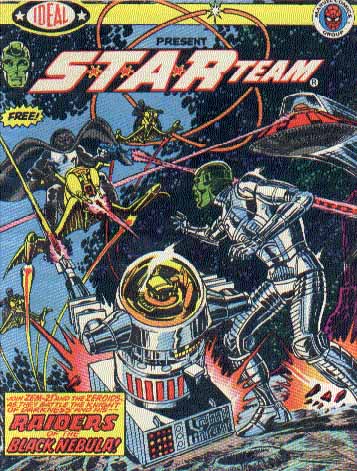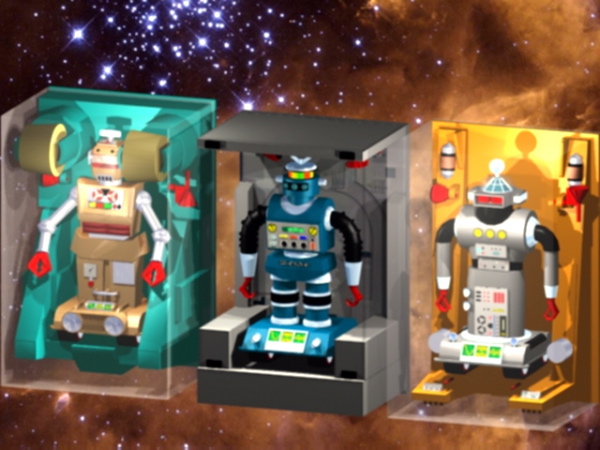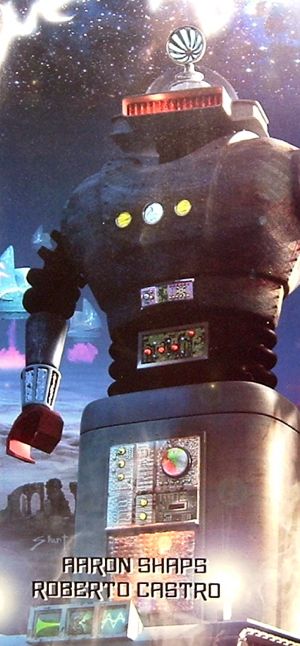|
|
In
the
late '60s came Ideal's Mighty Zeroids, "the workers of the
future".
These great robots originally cost five bucks, and later
even less, and
ran on tank treads powered by motors from Ideal's line of
Motoriffic
cars. Originally they were a trio: Zobor the Bronze
Transporter, Zintar
the Silver Explorer, and Zerak
the Blue Destroyer. Originally they
were individually packaged in clear plastic boxes with a
yellow
reversing ramp. Zobor had a cosmobile, Zintar a lunar
sled, and Zerak a
control station, each of which formed the back of the
plastic box.
There was also Zemo, a rare Zeroid made of various parts
from the
others. Later came Zogg, the Zeroid Commander, who could
activate
various devices. For the many variations and fascinating
history of the
Zeroids, check out James Gillam's Space Toys of the '60s,
which also
covers Mattel's Major Matt Mason and Colorforms Outer
Space Men (see
robot links). |
|
I
got Zintar, through an auction on eBay for around
$150,
about 300 times what he originally cost (and that's
good for a rare
robot). The only problem is that his two parts won't
stay together, so
you'd have to tape him together to run him. Zerak was
a great deal at
around $50, a great price for a Zeroid with treads
intact. He has the
small plate at the bottom missing, and a few other
small things. He was
also loose, without the box. For display purposes,
however, he's great. Often Zeroids are found with
pieces broken off or
the treads torn.
Because of this, some replacement parts are available
(see Wild Toys
and The Big Red Toy Box in Robot Links). Zeroids came
in clear plastic
boxes, packaged with a variety of color and design on
the outer
cardboard box. There was no padding, and the plastic
cases are often
found cracked.
Below
left:
The
diorama was made from cardboard packing pieces from
a toy
box, with stickers from the Mantech Terrorizer tank.
The background is
from a poster of the Horsehead Nebula. In the
foreground is a small
statue in a series by Vincent Di Fate called The Age
of Exploration,
"an artist's vision of the settlement of space" that
I got at a
liquidator store. This sculpture is about five
inches high and is
called "The Outpost on Argaeus".
|

|
|

|
|
Above
center:
Zobor
with Micronauts Micropolis
Interplanetary Headquarters by Mego. Every great
toy is built around
some idea. The Micronaut sets
are built around the plastic hinge, now used in
flip-top shampoo
bottles, but when introduced, Popular Science
magazine raved about the
amazing hinge that "never wears out". In the Mego
sets white square
pieces were joined by gray hinges in one of two
ways: snap it in one
way and the pieces hinge; the other way and
they're rigid. Mego billed
Micropolis as "the building set that never stops
growing" and it formed
a home for the 4" Micronauts.
Above
Right:
The
intrepid
Zerak advances, from a transporter, or maybe a CD
rack.
|
Above:
Zogg,
the Zeroid
Commander. Left: His hands are plus and minus
signs, showing the
positive and negative poles of power with which he could
activate the
Command Station and other Zeroid accessories.
Center: Zogg came
with a lazer (also spelled "laser") which he held. Flip
the
switch on the back of his clear torso and the
lazer lights and
blinks. Right: Flip the switch the other way and his
torso lamp lights
and blinks. Were they made today, Zeroids would no doubt
have LEDs. In
the '60s, however, Zogg's two AA batteries lit
flashlight bulbs. His
six eyes appear to be lit because they are translucent
and transmit
some light from his torso.
|
|
|

|
Top
L:
This
great
art is from the Zeroids issue of Playset magazine (see
Robot Links). R:
Lil' Android, a four inch tall remote controlled robot
from Radio Shack
holds up a Zeroids motoriffic motor. Like Zeroids,
Motoriffic cars ran
on two
AA batteries whch, like the motors, were snapped into
the motoriffic
chassis. Assorted car bodies could be snapped onto the
chassis. The
motor also ran the Botariffic line of boats.
|

|

|
Above
L: The last days of the
Mighty Zeroids, after endless rehashing
into countless packaging variations, came not with
a bang but a
whimper. Zogg lost his head (literally), and the
rest of him became the
Red Zeroid shown here. Gone were the motoriffic
motors, the reversing
ramps,
Zogg-powered accessories-- everything in fact but
the name. The
non-motorized Red Zeroid shown here came with the
Star Hawk space ship,
and the Blue Zeroid was available separately. All
these zeroids do is blink a dome lamp when you
turn them on.
While these Zeroids
may have lost something in play value, they are
still of interest to
collectors. If you had an extra Zogg head, you
could paint it with a
silver paint marker, attach it to a Red or Blue
Zeroid, and have a
custom silver Zogg. He wouldn't have a motor, but
the motors usually
don't work on Zeroids anyway, because the plastic
gear trains weren't
built to last. What do you expect for a five
dollar robot? Zogg is
marked Hong Kong, 1968 on the bottom, and forty
years later, you can
still find Zeroids in good shape. A little chrome
touch up paint and
voila! Le Zeroid! Not only that, but they're
poised to make a comic
book comeback in 2009 from Moonstone Books and
Captain Action
Enterprises.
Below R: The Star
Hawk
space
ship is the recolored Zem XXI Zeroid Explorer
Module (and it does look
better
in red and gray than in lime green and purple).
Now Zem 21 became the
name
of
a green-headed alien Star Team scout (shown on the
comic at right). The
Star Hawk still has the very
cool "motorized" wind-up Hatch from the Zem XXI.
Press a lever and the
hatch
slowly opens, and the landing pods and exit ramp
drop down. Originally
this also activated a Zeroid inside, which would
emerge and motor down
the ramp. Closing the pod door winds a spring,
which cleverly ticks
slowly back when you hit a lever, and once the
door opens, lowers a
ramp. The Star Hawk is nearly always found in
better shape than
this one, which is about grade -10, with a beat-up
box.
|

|

|
Top
R: The best part of the Star
Team was a free handout, 5 X 7
inch comic book, and you didn't even have to buy
anything to get it. Raiders
of the Black Nebula was
actually a 16 page Marvel comic,
written and drawn by their staff artists. In Space
Toys of the '60s,
James Gillam explains how Ideal faced a lawsuit
due to the similarity
of the Star Hawks to Star Wars: the Knight of
Darkness suggests Darth
Vader, and Zem 21 and the red and blue zeroids
seem similar
respectively to C3PO and R2D2. Ideal was able to
show that
all their toys preceded the movie, which may
explain why the Star Team
alien
has the same name as the former Zeroid space ship,
the Knight of
Darkness is a remodeled Captain Action, and other
oddities. This is a
fantastic book about all things Zeroid, Major Matt
Mason, Mattel's
Man in Space, and Colorform
Aliens (see Robot Books).
|

|

|
|
Above:
Planetzeroid.com
is
the creator of
the great new CGI Zeroids movie, "Return to Planet
Zero" (see Robot
Links). L: This scene from the film shows, left to
right, Zobor, Zerak,
and Zogg. R: CGI depiction of the original Zeroid
trio: Zobor and
cosmobile; Zerak and control station; and Zintar
and lunar sled. James
Gillam, the many- talented author of Space Toys of
the '60s did the
screenplay (see Books in the Robot Store).
|

Above:
The dazzling masthead of the
new Zeroids comics series (See our review below).
|
Zeroids:
The
Return #1. Moonstone Comics,
2010. A review.
Ever
since
teaser post cards were handed out at the
San Diego ComicCon in
2008, we've been waiting for the new
comics from Captain Action
Enterprises/ Moonstone Entertainment. Now
that the first issue, Zeroids:
The Return appeared in
2010, how does it rate?
On
the plus side, Roberto Castro
provides stellar cover art of a
rampaging Zintar on cover variant C
(shown here). Aaron Schaps
provides a postlude, "Here come the
Zeroids" in which he hits the high
points of planet Zero history, launching
the comics series with "Join
us for our journey into the Future,
alongside the coolest robot toys in
history."
On
the
plus side, Roberto Castro provides stellar
cover art of a
rampaging Zintar on cover variant C
(shown here). Aaron Schaps
provides a postlude, "Here come the
Zeroids" in which he hits the high
points of planet Zero history, launching
the comics series with "Join
us for our journey into the Future,
alongside the coolest robot toys in
history."
He's
listed for "story", and has
managed to round up Zem 21, Zintar,
Zerak, Zobor, Zogg, and even Zemo for the
cast, and artists Castro and
Craig Henderson have kept true to the
original Ideal designs.
On
the minus side, however, it's
not for kids. The mix of Roswell,
zombies, and rampaging robots also
includes an obligatory helping
of
college co-eds whose lines consist
entirely of stereotyped Valley Girl
cliches and cussing. Why don't we show the
rest of the cover? We've
shown you the best part, and the cover
artist's forte for drawing
realistic robots doesn't extend to the
female form, or perhaps he just
can't draw clothes.
Once
more,
the innocence of comics has been hijacked
for "uh-dult" graphic
novels, as if such gratuitous language and
graphics somehow improved
them (it doesn't), or lent versimilitude
(it doesn't). All it does is
limit the ranks of readers and shrink the
potential audience.
It
gets worse, as the back pages
promise Buckaroo
Banzai gets
the same
treatment. Fans waiting for the film
sequel instead will get "a
titilating mix of particle physics,
rock'n'roll, super-sonic speed,
beautiful women, and villians beyond
redemption." I can only imagine
Honey West, the female sleuth from the TV
show spun off from Burke's
Law as a "Sexy noir blend of
Marilyn Monroe and Mike Hammer" as
the
back page comic ad promises.
If
anyone wonders why kids' comics
from long ago are still collected
while graphic novels of today don't live
past their publication date,
I've got an idea. Today's publishers have
forgotten the magic
ingredient that makes us remember the
innocence of an earlier era of
toys and comics. When they again find
that, the real Zeroids will
return.
|


|
|
|










